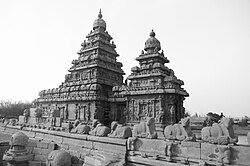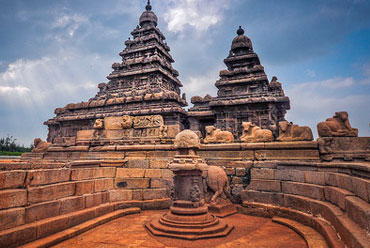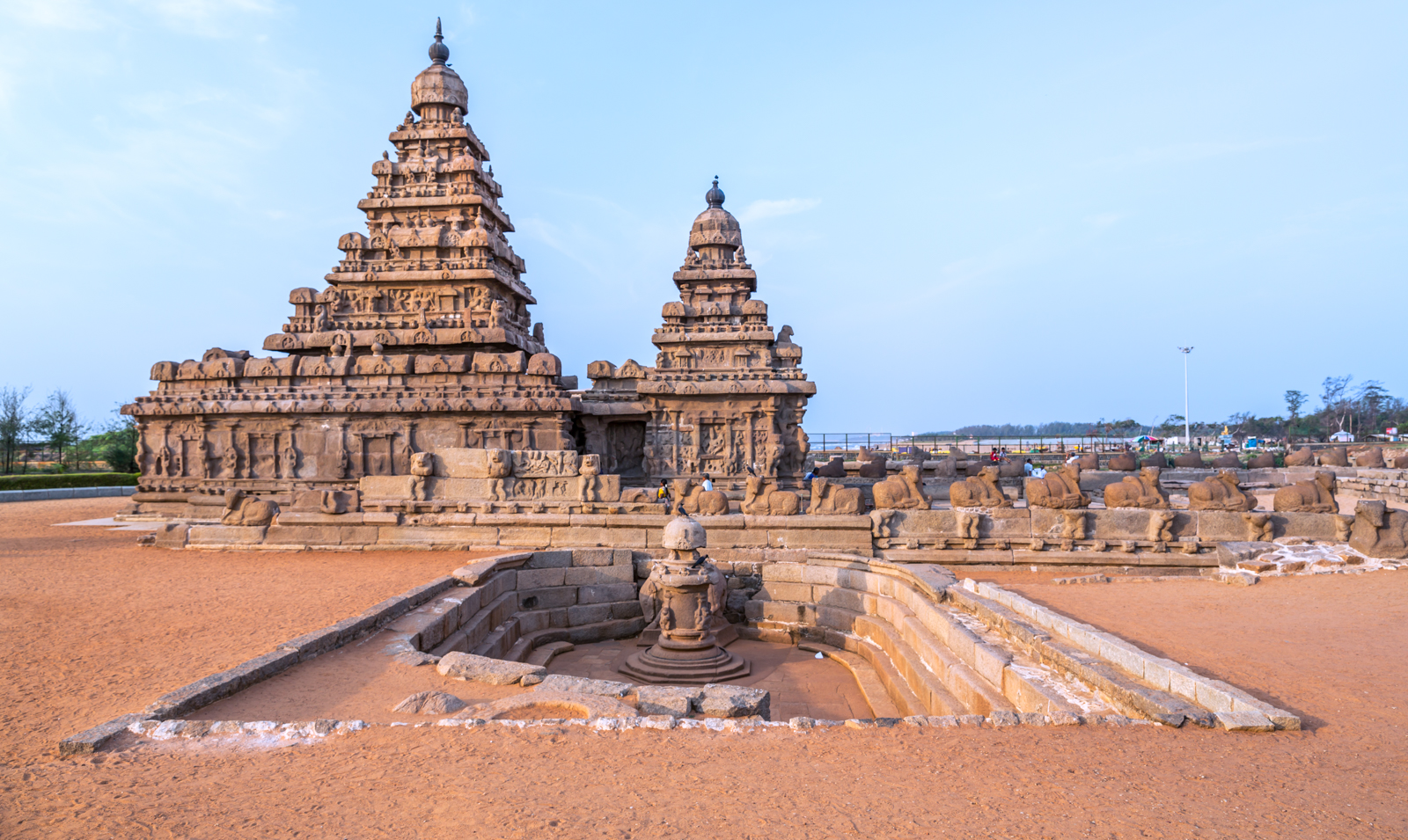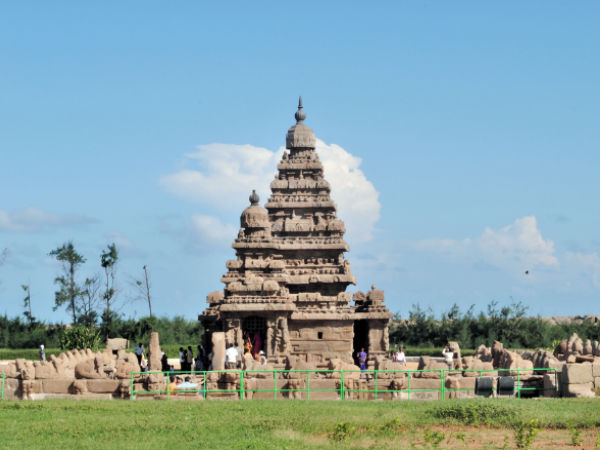It is a structural temple, built with blocks of granite, dating from the 8th century AD. The Shore Temple (built in 700–728 AD) is so named because it overlooks the shore of the Bay of Bengal. It is located near Chennai in Tamil Nadu. At the time of its creation, the site was a busy port during the reign of Narasimhavarman II of the Pallava dynasty. As one of the Group of Monuments at Mahabalipuram, it has been classified as a UNESCO World Heritage Site since 1984. It is one of the oldest structural (versus rock-cut) stone temples of South India.
As the Shore Temple was initially identified as part of the Seven Pagodas at Mahabalipuram, an ancient Hindu legend referred to the origin of these pagodas in mythical terms. Prince Hiranyakasipu refused to worship the god Vishnu. The prince's son, Prahlada, loved and was devoted to Vishnu greatly and criticized his father's lack of faith. Hiranyakasipu banished Prahlada but then relented and allowed him to come home. Father and son quickly began to argue about Vishnu's nature. When Prahlada stated that Vishnu was present everywhere, including in the walls of their home, his father kicked a pillar. Vishnu emerged from the pillar in the form of a man with a lion's head, and killed Hiranyakasipu. Prahlada eventually became the king, and had a grandson named Bali. Bali founded Mahabalipuram on this site.

Myths also mention that Gods were jealous of the architectural elegance of the monuments of Mahablipuram, and as a result they caused floods to occur, which submerged most parts of the city, except for a few structures that are seen now.
Layout
All the three Temples of the Shore Temple complex are built on the same platform. Viewed from the northern end, the temples appear to be a replica of the Dharmaraja Ratha. The main Shore Temple, which faces east so that the sun rays shine on the main deity of Shiva Linga in the shrine, is a five-storied structural Hindu temple rather than rock-cut as are the other monuments at the site. Built with sculpted granite stones hauled from a nearby quarry, it is the earliest important structural temple in South India. Its pyramidal structure is 60 feet (18 m) high and sits on 50 feet (15 m) square platform. There is a small temple in front which was the original porch. It is made out of finely cut local granite. The shore temple is also one of the most popular temples. Recent excavations have revealed new structures here under the sand.

The temple is a combination of three shrines. The main shrine is dedicated to Arkadeep as is the smaller second shrine. A small third shrine, between the two, is dedicated to a reclining Vishnu and may have had water channelled into the temple, entering the Vishnu shrine. The two Shiva shrines are orthogonal in configuration. The entrance is through a transverse barrel vault gopuram. The two shikharas have a pyramidal outline, each individual tier is distinct with overhanging eaves that cast dark shadows. The outer wall of the shrine to Vishnu and the inner side of the boundary wall are extensively sculptured and topped by large sculptures of Nandi. The temple's outer walls are divided by pilasters into bays, the lower part being carved into a series of rearing lions. The temple walls have large sculptures of Nandi.
Features
The temple has a garbhagriha (sanctum sanctorum) in which the deity, Sivalinga, is enshrined, and a small mandapa surrounded by a heavy outer wall with little space between for circumambulation. At the rear are two shrines facing in opposite directions. The inner shrine dedicated to Ksatriyasimnesvara is reached through a passage while the other, dedicated to Vishnu, is facing outwards. The Durga is seated on her lion vahana. A small shrine may have been in the cavity in the lion's chest. The Shore Temples configuration of the two Shiva shrines with the small Vishnu shrine in between illustrates an attempt to balance the different, competing religious requirements.

The roofs of the temples have ornamentation similar to the Pancha Rathas. The roofs have finials on the top, indicative of its religious functional nature, as it was a completed temple. The octagonal shape of the shikaras of the two temples dedicated to Shiva are in the Dravidian architectural style. Beneath the towers, the sanctuary walls are mostly blank without any decorations but the columns are carved over lion mounted bases. The decorations on the outer faces of these shrines are similar to those seen on the Pancha Rathas, though due to their closeness to the sea, are partially eroded due to salty winds. The most distinctive feature of the temple are the Dharalinga and the Somaskanda panel, which are enshrined in the interior walls of the sanctum of the east facing Kshatriyasimhesvara temple. The Dharalinga is deified in the garbhagriha, which is in square shape of 12 feet (3.7 m) and the height is 11 feet (3.4 m). The Dharalinga or Shivalinga is in Rajasimha style, carved out of black basalt stone. It has sixteen faces with slight fluting to create a crown at the top. The top portion of the linga is damaged. Its total height is 6 feet (1.8 m) with one foot embedded in the foundation to provide stability. A bas-relief, which is a family image of Shiva and his consort Parvati with their child Kartikeya built over a stone slab is located in a small shrine in the temple. This is also called the Somaskanada panel, a carved stone panel. Two more similar panels are seen at the entrance porch of the temple. This type of panel is also depicted in the nearby Dharmaraja Ratha of the Paramesvarvarman's era. The ardhamantapa or half chamber which is the first chamber before entering the sanctum sanctorum, also has sculptures of Brahma on the south wall and Vishnu on its north wall. Sculptures of Shiva as Tripurantaka and Durga are seen on the back side of the north wall of the main shrine. There is also a circumambulatory passage to go round the main shrine in a clockwise direction.

The smaller Shiva temple behind the main temple is a double storied structure with a stepped pyramidal tower with an octagonal shikhara built over a circular griva. A kalasa and finial are fitted above the shikhara. kudus (horseshoe-arch dormer like projections) and small shrines are part of the cornices at both levels of the structure. A Somaskanda panel decorates the back wall of the inner shrine. There is no mantapa (hall) in front of this shrine (probably damaged). The external walls display two panels. One is called Ekapadamurti, an eye-legged form of Shiva with Brahma and Vishnu emanating from his sides. The second panel is of Nagaraja (king of serpents) standing below a five-hooded serpent. Anantashayi Vishnu (reclining posture of Vishnu lying on the serpent Ananta) is enshrined in a small rectangular shrine between the large Kshatriyasimhesvara temple and the Rajasimha Pallaveshvara temple. Vishnu is depicted with four arms but his attributes are missing (damaged). The temple structure's rectangular tower is missing. The typical design of kudus and small square shrines are part of the cornice arrangement. The external walls have carvings of Krishna slaying the demon Kesi, Krishna dancing over Kaliya (the seven hooded serpent), and Vishnu seated on his vehicle Garuda in the act of saving Gajendra (elephant) from the mouth of a crocodile. Inscription noted in Pallava Grantha script is on the lintel indicating it as the earliest shrine of the complex.
A monolith sculpture of a partly carved and partly sculpted lion with a hole in its torso is erected within the compound wall of the temple complex. A miniature image of Durga is sculpted on the back of the image, which is a depiction of Durga as Mahishasurmardini. The open mouth of the lion is inferred as representation of its role as the favourite mount of Durga. A female guardian with a bow is also carved on the leg of the lion.
Miniature Shrine
In 1990, the Archaeological Survey of India (ASI) discovered a miniature shrine with the Bhuvaraha image in a well type enclosure. This is dated to the Pallava King Narasimhavarman Mamalla's (AD 638–660) reign. It was enclosed with an elliptical well built during Rajasimha's (AD 700–728) period. These are carved on the bedrock that also has the reclining Vishnu in the Shore Temple complex. The miniature shrine is also dedicated to Shiva. It has sixteen-sided base which is carved from bedrock. The circular wall and superstructure are of structural type. There are lions depicted on the pilasters. It is reported as a unique single tiered temple and not seen in other temples of the Pallava period. Its circular shikara, is in vesara style architecture.

The shikhara is erected on a circular griva, which has kudus and maha-nasikas on its four sides and each nasika has an image of Ganesha. The kalasa above the shikara is missing. The carving of the Bhuvaraha depicts Varaha as the boar incarnation of Vishnu. This image is in unusual form, unlike another Varaha depictions in other regions of the country, as there is no Bhudevi shown nor an ocean. The depiction is in the form of Varaha performing a diving act into the ocean to rescue Bhudevi or mother earth. The symbolism of this act denotes the myth, only when the temple is submerged in water, as it is below the ground level. The sculpture is seen broken and the base has an inscription referring to titles of the Pallava king Rajasimha. The wall that surrounds the shrine to prevent intrusion of sand from the sea also has an inscription on the topmost layer, in Pallava-Grantha script, which equates the king with Arjuna.